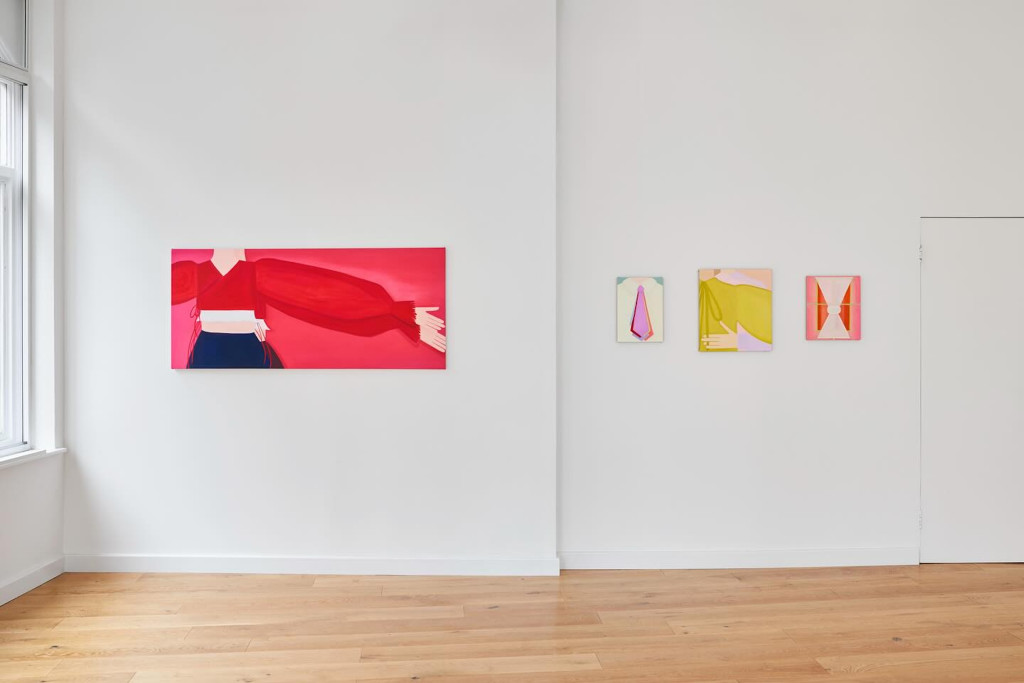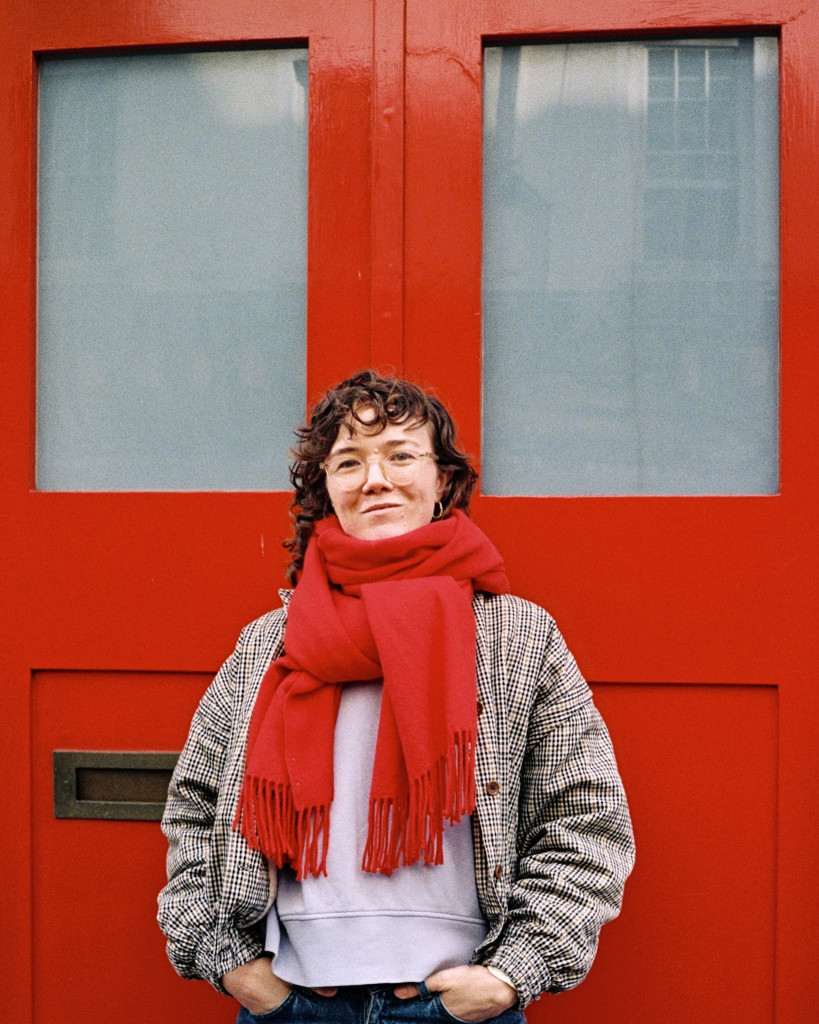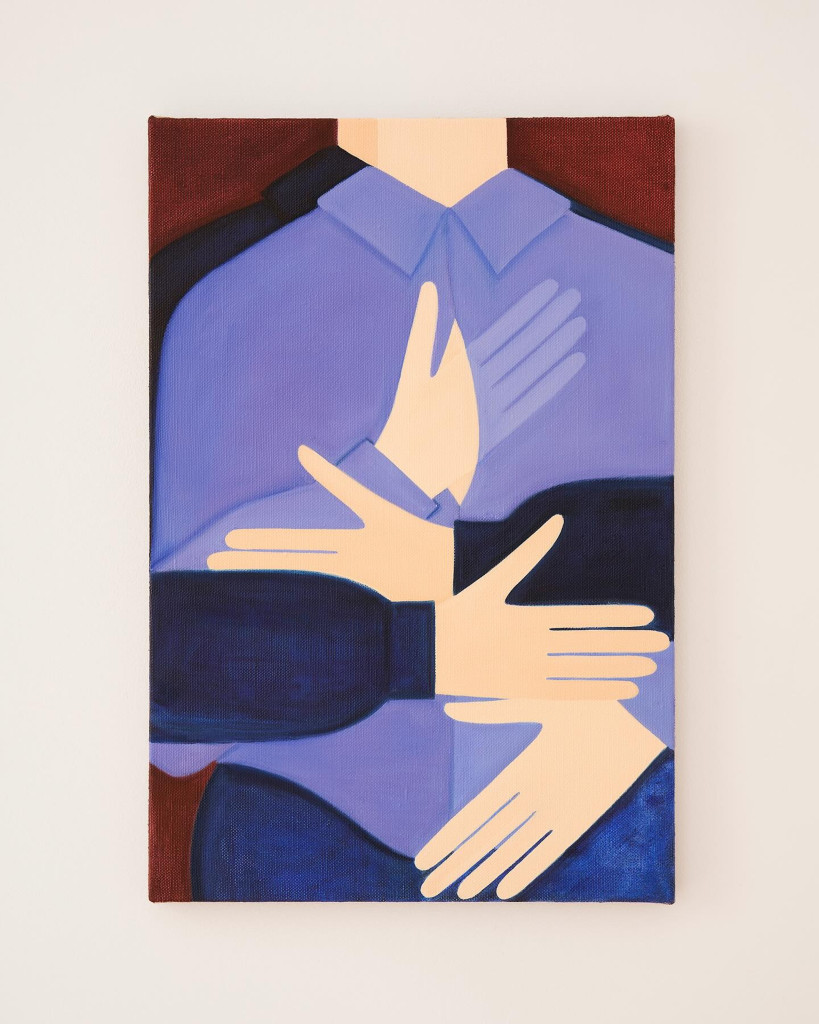A new body of work by Ellie MacGarry (b. 1991, UK) for her first solo exhibition at the gallery.
If you would like to request a catalogue, please email: cedric@cedricbardawil.com


In Greek myth, Echo was an Oread who was used as a pawn in Zeus’ dreadful game to deceive his wife Hera and frolic with the beautiful nymphs on Earth. Aggrieved and wrathful, Hera descended from Mount Olympus and blamed Echo for her husband’s philandering. Hera fixed a curse on Echo and rendered her able only to speak the last words spoken to her. Hera’s hex isn’t a disaster until Echo falls in love with the beautiful Narcissus and, unable to tell him the truth of her passionate feelings, she is forced to merely observe him as he falls deeper in love with himself. Ellie MacGarry has chosen ‘Echo’ for the title of a new body of work that is interested in the doubling of sounds and bodies, silence and touch, as well as the ways in which love and desire can be communicated by gestures alone, when the meaning of words falls away. MacGarry is a mythmaker but whose faceless figures are modern and not classical in ethos, emphasizing almost inadvertently the spatial absence which surrounds them. Her timely concern for hard, no-nonsense paint quality and usually for strong ‘close’ values in colour offer her figures a physically flat and psychologically adamant stance which demonstrates the fine accuracy of her paint handling. MacGarry’s paintings of young people dressing, touching, and dancing, all wrestle with what constitutes that strange place that we call the interior life. Or, to put it another way, MacGarry’s cropped portraits and ordered interiors ask what it means to prepare oneself to face the world.
Found near a columbarium on the Via Ostiensis, the much-travelled road that connected Rome with Ostia, the funerary relief of the Decii depicts a family of freed slaves. Husband and wife clasp their hands as a symbol of their marriage, while their son, delicately holding a dove, stands between them. The relief is made from Lunar marble. The inscription names them as A. Decius Spinther, Decia Spendusa and A. Decius Felicio, from the early second century AD. When MacGarry visited the Eternal City, she was struck by how the relief played with the forms of time, and noted the way that the young son clutching a dove is almost crowded out of the scene, as though added by the sculptor later. MacGarry was struck by the ‘joining of the right hands’ (dextrarum iunctio), often, though not always, signifying marriage. It is easy to see why MacGarry found the relief so striking. In her paintings, arms are forever reaching out across, towards, and through the bodies and clothes of others. In Drafts (2023), for example, four bodies, in two rows of two, hold hands (out of sight) and touch one another’s backs (impossibly transparent through their pastel-coloured silky dress shirts). MacGarry stressed to me that these are not always images of pure affection, but rather expressions of ‘connections, as well as missed connections’, or about how one day we might feel a particular emotion but the next differently, like ‘drafting and re-drafting an email.’ It’s also possible to see that these are not lovers or friends at all, but strangers forced to be close to one another in a crowd or on a tube platform. We sometimes forget how close strangers are to us, and how distant we might feel from former versions of ourselves. As in much of MacGarry’s work, Drafts appears to operate at the threshold of performance as though each moment in her world is always about to transcend the circadian cycle of wearing clothes and having a body into a colourful scene of uncoiled dance and revealed theatre.
In his essay ‘Phenomenology of Perception’, written in Paris in 1945, the French philosopher Maurice Merleau-Ponty writes that there ‘is not a single word or human gesture – not even the habitual or distracted ones – that does not have a signification.’ In other words, every gesture of our hand, or every word that we have spoken perhaps a thousand times, is freighted with meaning. I thought of Merleau-Ponty’s essay as I spent an afternoon in MacGarry’s studio, which is lit by one of those wonderful glass-panelled sky ceilings that make you think you are waiting for a train at the Gare Saint Lazare, and where Merleau-Ponty might have stood, holding his pen or pursing a cigarette, in 1945 as his city was liberated. There, I looked closely at The Step (2024) in which two figures in blue shirts—one coal-navy, the other a mauve-cobalt blue—stand close, facing in the same direction, which is to say they face us; indeed, they are stood close enough that the figure behind, in the coal-navy, has put both arms around their companion in an embrace that oscillates between comfort and control. Our focus, in the mauve-cobalt, puts one hand on their own chest, in between the buttons, and the other across their body. Two of the pairs of hands are arched 45 degrees; the other two at 90. The composition has a remarkable geometry. You spend a moment wondering whether this is a painting about love or restraint until you realize it is about both. Often, we separate out love and freedom as two noble but irreconcilable aspirations: you can either be loved or you can be free. That’s it. But sometimes we want to be held down; to make the choice not to choose. In this way, The Step contains a tenderness that is reminiscent of Joanna Piotrowska’s monochrome studies in human touch and feeling, such as her untitled images of wandering and caressing hands that layer one on top of the other like a palimpsest of reassurance. They, too, hold down as a way of expressing love.

It is impossible not to be seduced by paintings like Counterpart (2024), an unusually wide work at 1:2.3 ratio, which depicts two figures, perhaps about to dance together, in blood-red cropped blouses face-to-face and arm-to-arm. Resembling two matadors locked in a mano a mano, or hand to hand, they appear like rival bullfighters preparing for a duel or a duo with a camaraderie of spirit. In its redder-than-red, hard-edged forms and sensitivity to the way the body moves, Counterpart reminded me of Alex Katz’s paintings for dance and theatre, especially Song, Laura Dean Dance Co. (1977). In both works, we identify with the figures not because we necessarily see ourselves in them, or because their bodies of unto themselves remind us of our own, but because the postures are so unnatural and so difficult to maintain for an extended period that we ache with them. We cannot outstretch our arms indefinitely. We cannot raise one arm over our heads and remain comfortable for long. But in those moments of exertion, we test the limits of what our body can do and be in space and, for MacGarry, what it means to do that with another person. If Katz’s chic seventies vision of minimalist choreographer Laura Dean, best known for her collaborations with Steve Reich, feels intensely New York, then there is something distinctly London about MacGarry’s portraits of millennials dancing, touching, and cosplaying exoticism in their compact apartments.
If Counterpart is a reverie of dance embodied as all sweat, sex, and sangria, then The Wait (2023) is a formal riposte. We are not in a cramped dance hall anymore, or someone’s back bedroom, but somewhere closer to a Giorgio de Chirico dreamscape, if it was viewed up close and not from an aerial distance. In the cooled tonal schema of the heavy sky backdrop, fluctuating from deep indigo to lavender, two figures, one in a formal collar and the other in a bow, though their faces are not represented, stand apart. One wonders why they are each wearing black formal gloves, and if the suspended animation of their symmetrical stance is auspicious or terminal. In Pina Bausch’s Nelken, there is a choreographed scene in which a dancer in a full black suit and silk tie stands in a stage full of pink carnations and signs the hauntingly beautiful lyrics to Ella Fitzgerald’s The Man I Love. It is a performance that has always moved me because it is as though the gestures, quite literally, communicate with the exactitude of words: the crossed hands over the middle of the chest, for instance, signify ‘love.’ Like Bausch’s mutely singing signer, MacGarry’s pictures occupy a hybrid gestural space that feels at once like dance and like poetry. Hers is often a surreal topography, none more so than in The Wait, and yet it is received as resolutely real, as hands communicate with the sincerity of words. We do not know where we are or who these people are, but know what they mean because their hands and arms and torsos tell us. It is impossible to discuss MacGarry’s work without reference to her remarkable sartorial instinct.
Much more so than the uniformity of the standard necktie, the bow tie hints at intellectualism or eccentricity, real or feigned, and sometimes suggests technical acumen, perhaps because it is so hard to tie. This sense of style meeting difficulty animates Knot (2024), a work that half resembles a cuboid vortex of light and centripetal colour while remaining resolutely a rendering of a flipped bowtie. MacGarry’s bows are inspired, in part, by the bowties, knots, and loops in works by the eccentric Dutch artist René Daniëls. Rather than depicting bowties on bodies, Daniëls’s Dada-inspired ties seem to float and dance upon the surface of the paintings like they are their own excuse for being. They wrestle up against one another, and skirmish in brightly coloured hues of reds, and oranges, and yellows. As with Daniëls’s, MacGarry’s bowties feel held in place as markers of an extravagant exuberance that refuses to be funnelled into categories of use-value. They are strange and present, but still manage to retain something of the texture and material of the fabric, even when reduced to its simplest composition.
Many of MacGarry’s works are made with oil on flax canvas while others, like Ties (2024), were produced on herringbone canvas which offers such a rich material effect that plays sleight of hand with our senses. As we see (and almost touch, by seeing) the minute diagonals and lines, reminiscent of a tweed jacket, we are surprised—not unlike encountering Meret Oppenheim’s furry teacup and saucer for the first time—that the subject feels so at odds with the form. But, like the great camp stage designer and painter Domenico Gnoli, whose close-up representations of herringbone ties and crisp collars were both so voguish and yet so vulgar, MacGarry is an artist who contains multitudes. In her pictures of bodies, of dress, and of interiors, this is an artist who speaks in a unique vocabulary to remind us of the secrets, the joys, and the intimacies of our lives, in both noise and silence.
Exhibition catalogue essay by Matthew Holman

